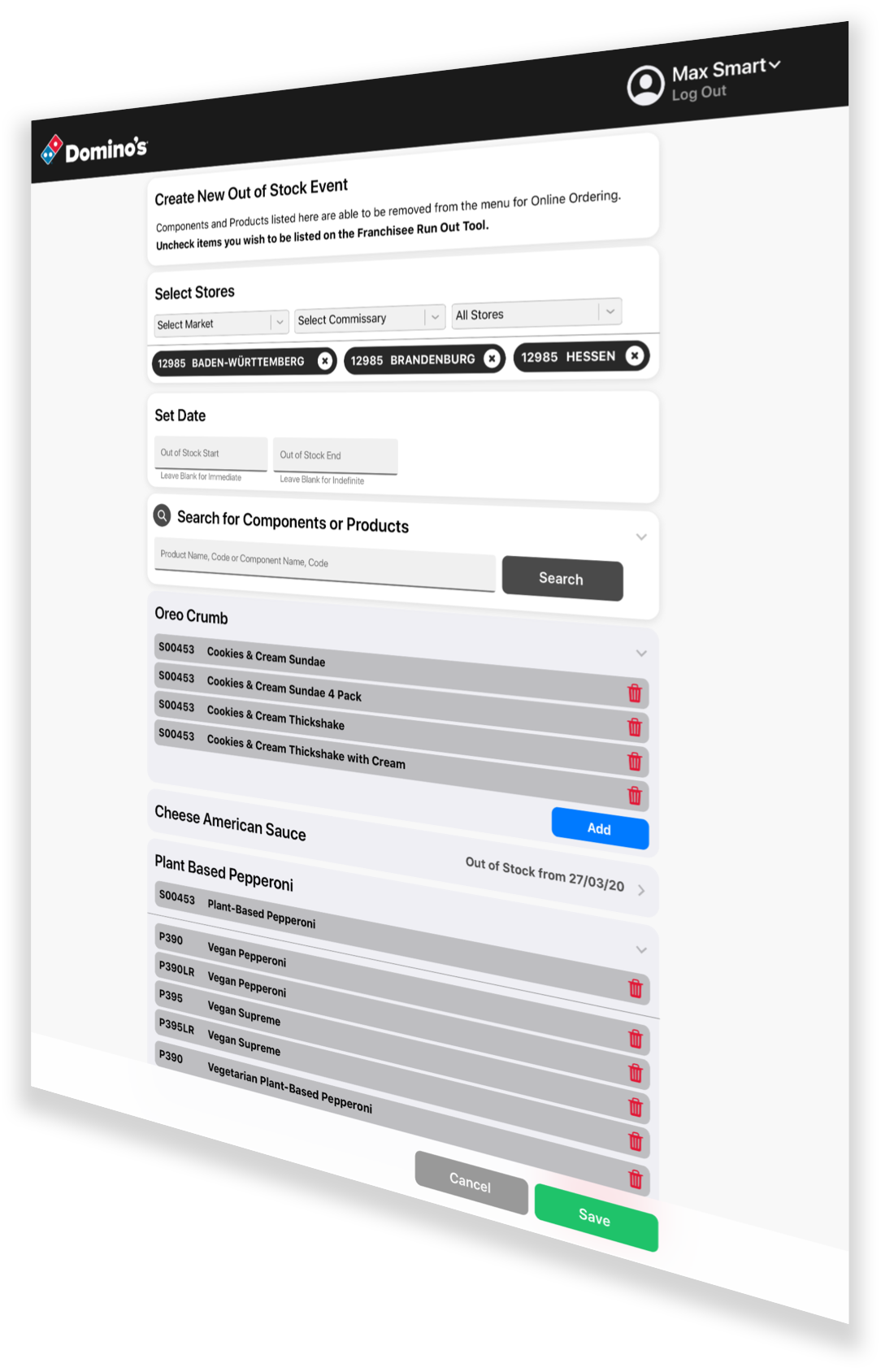
Out-of-Stock Tool
Desktop Web | Mobile Web
A trial-by-fire for our new design language - a foray into an internal tool.
Design goals of a dramatically improved user experience for franchisees and DPE’s marketing team ran alongside a business requirement for full legacy feature support from an almost twenty year old tool, as it was expanded to 10 additional markets
Research
DPE’s existing stock and voucher management tools had become a pain point for franchisees and global marketing teams. Created with a functionalist view to interface, with little to no user research, it was challenging to use efficiently, with backend complexity contributing to a sluggish and frustrating experience. While a new more performant backend was not on the cards, a refreshed, modern web frontend was seen as the most expedient way to a faster, friendlier tool.
Scope was already established by the existing product. Though some features were considered legacy by the business initial investigations revealed they were still in use (we used the gating criteria of >5% of users more than twice a month actively using the feature). We did however put together an analytics-driven retirement list for under-utilised features as a runway to progressively simplifying future scope.
One of the challenges for this project was the diverse range of users. This included power users already extremely familiar with the existing solution, casual franchisee users who would only engage with the tool when an ingredient was out of stock, and new users, who struggled with the complexity of the existing tool.
This would be deployed not just in Australia and New Zealand, but 10 further international markets. As a result, string length varied wildly - not just in product names but also in titles and CTAs. Translations would be managed through Locize and tested exhaustively by my team.
Adding complexity was the variety of supported devices.. While the legacy tool was limited to desktop web browsers (specifically Internet Explorer), this new version would need to support modern web browsers and mobile screen sizes on iOS and Android.
Design
Following an extended period of hands-on testing of the existing tool, observation sessions of existing users in store environments, and full end-to-end user journey mapping, I broke down what elements could be produced with existing components from the Domino’s Design System, and what new design would be required. The more data-dense elements of the Voucher and Runout Tools would need a cell-like structure, but we resisted a table view, as this didn’t give clear legibility. and wasn’t friendly for a mobile user. We settled on a structure that gave every item its own button-like cell, with big, easy to tap controls. This made the list view longer, but in testing we found editing multiple items simultaneously was an extreme outlier, and more likely to be done in a head-office context on a larger display.
Anchored bottom of view controls made it obvious how to save and cancel an edit, and CTA colours flowed through from the Design System for pleasing, accessible continuity.
For editing stock or vouchers for multiple stores, we developed a chip system that could be used to quickly select a whole market or store group, and edit that down to a shorter list if required. This was a debated design choice as store names could have a substantial string length, but by using this format instead of another table-style view we could clearly delineate functional areas, and reduce the potential for monotony or incorrect input.
Deployment
The new Voucher and Runout Tools were deployed on a intra-market basis, first across Australia and New Zealand, then Japan finishing with a staged roll out across Europe, interfacing with the team there to troubleshoot any line-wrapping or string length related issues - which ended up being minimal. Though the new tool didn’t resolve the majority of the backend challenges, the new front end was lauded by franchisees for being accessible and easy to use for new employees - taking a substantial load off managers and franchisees. Though this did not have specific success criteria, usage of the tool in Europe and Japan resulted in dramatic improvements in stock management and customer satisfaction.
